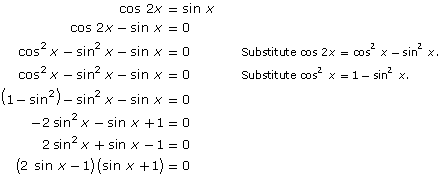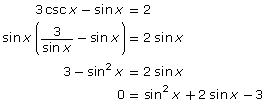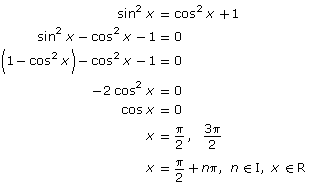Module 5: Lesson 4
Self-Check 4
- Questions 1.a., 1.d., 2.c., 3.c., 6, 8, and 10 on pages 320 and 321 of the textbook
-


Therefore, the solutions are


Therefore, the solutions are
-


Therefore, the solutions are x = 90°, 270°.
This solution can be verified graphically as shown.

Because the intersections with the x-axis are the same as the solutions (x = 90°, 270°), the solution can be said to be verified graphically.
-
- The equation 3 csc x − sin x = 2 can be converted into a solvable equation in terms of only sine as shown.

Solving the equation gives


Therefore, the solution is
- The equation 3 csc x − sin x = 2 can be converted into a solvable equation in terms of only sine as shown.
- Sanesh’s error occurred in the first step. By dividing both sides by cos x, Sanesh failed to find all of the possible solutions. A correct method to solve this equation is shown.


Therefore, the solutions, when written in general form, are
x = 30° + 360°n, n ∈ I, x ∈ R
x = 90° + 360°n, n ∈ I, x ∈ R
x = 270° + 360°n, n ∈ I, x ∈ R
x = 330° + 360°n, n ∈ I, x ∈ R
- By the zero product property, 7 sin x + 2 = 0 or 3 cos x + 3 = 0 or tan2 x − 2 = 0. Consider the solutions to each of these separately.
For 7 sin x + 2 = 0,

This will give two solutions for the given domain.
For 3 cos x + 3 = 0,

This will give one solution for the given domain.
For tan2 x − 2 = 0,

This will give four solutions, two for
By inspection, all of the solutions are different so there are seven solutions over the interval 0° < x ≤ 360°. and two for
and two for  in the given domain.
in the given domain.
-
© 2012 Alberta Education
